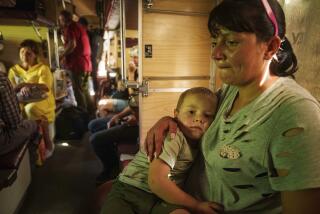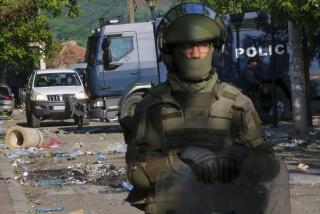Croatian Troops Reportedly Mass on New Fronts : Balkans: Government forces clash with rebel Serb holdouts during mop-up operations in recaptured enclave.
- Share via
ZAGREB, Croatia — As Croatian troops were reported massing on new fronts, holdout pockets of rebel Serbs clashed with government forces Thursday, despite an hours-old cease-fire that no one seemed to notice.
U.N. officials said Croatian army troops attempting to mop up the small Serb enclave they recaptured this week encountered resistance for about two hours from a unit of about 200 Serb soldiers.
While several hundred Serbs turned over their weapons and surrendered in the Croatian town of Pakrac, about 65 miles southeast of Zagreb, fighting continued farther south, U.N. officials said late Thursday.
The skirmishing was sufficiently intense to force U.N. special envoy Yasushi Akashi to scrap a trip to the region, where he had hoped to oversee a demobilization ceremony.
“It doesn’t seem like it’s over yet,” a U.N. official said. “The pockets of resistance are still active.”
*
The United Nations also reported that Croatian soldiers in the recaptured town of Okucani, about 12 miles south of Pakrac, were looting homes and properties of Serbs who fled. More than 5,000 Serbs are believed to have fled southward to Bosnia-Herzegovina.
Perhaps even more ominous for peace were indications that the Croatian army, flush from the relative ease with which it took the enclave known as Western Slavonia, has moved tanks and hundreds of troops into position near two larger, Serb-held, U.N.-protected regions.
The operation to take Western Slavonia was swift, allowing government forces for the first time to regain part of the land seized in 1991 by Serbs who rebelled over Croatia’s decision to secede from the Yugoslav federation. The ensuing war killed 10,000 people.
But Serbs responded Tuesday and Wednesday by bombarding Zagreb with rocket-carried cluster bombs, killing six and wounding almost 200. The sites hit included a children’s hospital, the National Theater and private apartment buildings.
Air raid sirens blared in Zagreb again Thursday. No shelling was reported, and the Defense Ministry said the alert was precautionary.
About 130 miles east of the capital, Croatian and Serb troops were grouping near the city of Osijek, on opposite sides of the border of an especially volatile Serb-held enclave that abuts Serbia, U.N. sources said.
The standoff had not produced any exchange of gunfire by Thursday night, U.N. officials said, but the situation was tense.
And in south-central Croatia, Croatian troops marched past U.N. observation posts meant to monitor a buffer zone between Serb and Croat enemies, ejecting or harassing U.N. peacekeepers and restricting their movements.
The actions on two fronts raise the specter of a new offensive and came as Croats and Serbs exchanged threats of retaliation.
Croatian officials, while not commenting directly on troop movements, said the army’s actions were purely preventive.
But a U.N. military source said of the assault on the observation posts: “This means they (the Croatians) are trying to hide something. These guys are better at this than we are--they conceal their intentions very, very well.”
With the Croatians apparently moving into position, the Serbs are also talking of retaliation.
Bosnian Serb leader Radovan Karadzic traveled to Knin, headquarters of the Croatian Serbs in the so-called Krajina region, to pledge support to his rebel counterpart, Milan Martic.
Martic has vowed he will take back the land, and Karadzic pledged to help him.
*
Karadzic, speaking on a Cable News Network program honoring former President Jimmy Carter, accused the Croatians of “slaughtering innocent Serbian people” in Western Slavonia.
Reporters who witnessed Thursday’s surrender said an officer was handcuffed and militia members led away at gunpoint by Croatian soldiers. The women and children who stayed behind seemed frightened and dismayed.
Indeed, how the Croats treat the Serbs who choose to remain in the reconquered enclave will be an important test of whether Croats can govern with fairness toward ethnic minorities and respect their human rights, analysts say.
Meantime, they note, it has also become increasingly clear that the international community will not punish Croatia for its military offensive, which shattered a three-year cease-fire and violated U.N. truce lines.
Croatia has indicated that it has no intention of giving its reclaimed land back. Critics say it appears the use of military aggression has once again achieved its goal, contrary to U.N. and world peacekeeping objectives.
“We’d like to believe we are not legitimizing aggression in any case,” said Fred Eckhard, Akashi’s spokesman, “but just moving, falling back each time the parties break another agreement between themselves or with us, and try to stabilize or push them back in the direction of a negotiated settlement. . . . We’ve been quite flexible in that sense, and we’ve been pushed around in the process.”
(BEGIN TEXT OF INFOBOX / INFOGRAPHIC)
Key Serb Weapon
Rebel Serb forces this week fired rockets with cluster bomb warheads on Zagreb. The missiles spew bomblets that explode on impact. Unexploded bomblets pose a special risk to children, who often believe that they are toys. No shelling was reported Thursday in the Croatian capital, but rocket attacks Tuesday and Wednesday scattered up to 2,000 bomblets across the city.
Cluster bombs: Each bomb contains 288 bell-shaped bomblets. Each bomblet contains 420 steel spheres. 10% to 15% do not explode during shelling.
Bomblet lethal radius: 33 feet
SPECIFICATIONS
M-87 Orkan Multiple Rocket System
Yugoslav-built
ROCKET
Caliber: 262 millimeters
Max. range: 31 miles
Max. velocity: 3.937 feet/sec.
Firing rate: 1 rocket/2.3-4 sec.
VEHICLE
Crew: 5
Max. road speed: 50 m.p.h.
Max. range: 373 miles
*
Sources: Jane’s Armour and Artillery; Reuters
More to Read
Sign up for Essential California
The most important California stories and recommendations in your inbox every morning.
You may occasionally receive promotional content from the Los Angeles Times.











